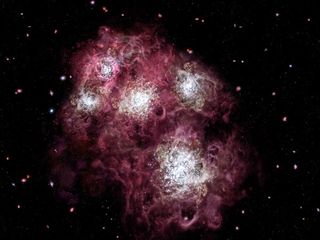Farthest Galaxy Found, Perhaps

Astronomers have glimpsed what may be the farthest galaxywe?ve ever seen, providing a picture of a baby galaxy born soon after the beginningof the universe.
Images taken with the Hubble Space Telescope have revealed thegalaxy at almost 13 billion light-years away, making it the strongest candidatefor the most distant galaxy ever seen, said European Southern Observatoryastronomer Piero Rosati, who helped make the discovery.
Since the galaxy is so far away, its light took ages toreach us, so what we see now is a snapshot of how this galaxy looked 13 billionyears ago. At thatpoint in time, the galaxy would have been newly formed, so the newobservations provide a baby picture.
"We certainly were surprised to find such a bright younggalaxy 13 billion years in the past," said astronomer Garth Illingworth ofthe University of California, Santa Cruz, a member of the research team. "Thisis the most detailed look to date at an object so far back in time."
The younggalaxy, called A1689-zD1, was born about 700 million years after the BigBang that scientists think created the universe. For most of its early life,the universe languished in "dark ages" when matter in the expandinguniverse cooled and formed clouds of hydrogen. Eventually matter began to clumpinto stars and galaxies that radiated light, heating up the universe andclearing the fog.
Scientists think this newly discovered galaxy may have beenone of the first to form and help end the dark ages.
"This galaxy presumably is one of the many galaxiesthat helped end the dark ages," said astronomer Larry Bradley of JohnsHopkins University in Baltimore, leader of the research team. "Astronomersare fairly certain that high-energy objects such as quasars did not provideenough energy to end the dark ages of the universe. But many young star-forminggalaxies may have produced enough energy to end it."
Get the Space.com Newsletter
Breaking space news, the latest updates on rocket launches, skywatching events and more!
The discovery was made possible by a naturalmagnifying glass ? the galaxy cluster Abell 1689, which lies between us andthe distant galaxy. Abell 1689's gravity is so strong it bends light thatpasses near it, acting like a giant zoom lens that magnifies what we see.
"This galaxy lies near the region where the galaxycluster produces the highest magnification," Rosati said, "which wasessential to bring this galaxy within reach of Hubble and Spitzer."
The discovery, announced today, will be detailed in the AstrophysicalJournal.
- Video: Hubble Repair Missions
- The Best Hubble Images
- Video: Death Star Galaxy
Join our Space Forums to keep talking space on the latest missions, night sky and more! And if you have a news tip, correction or comment, let us know at: community@space.com.

Clara Moskowitz is a science and space writer who joined the Space.com team in 2008 and served as Assistant Managing Editor from 2011 to 2013. Clara has a bachelor's degree in astronomy and physics from Wesleyan University, and a graduate certificate in science writing from the University of California, Santa Cruz. She covers everything from astronomy to human spaceflight and once aced a NASTAR suborbital spaceflight training program for space missions. Clara is currently Associate Editor of Scientific American. To see her latest project is, follow Clara on Twitter.
Most Popular

